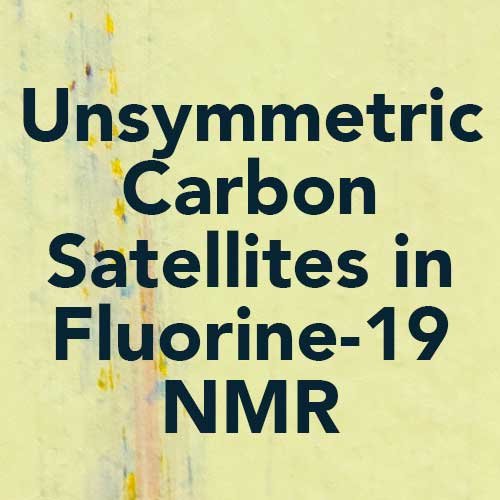Welcome to Nanalysis’ benchtop NMR Blog
We love benchtop NMR! In this blog section, you will find all things benchtop NMR. Please contact us if you would like to discuss about your project.
Category
NMR Topics
- 100 MHz NMR
- 11B NMR
- 129Xe NMR
- 13C NMR
- 19F NMR
- 19F NMR Spectroscopy
- 1H NMR
- 1H NMR, 19F NMR
- 207Pb NMR
- 31P NMR
- 3H NMR
- 60 MHz NMR
- APT
- Agrochemicals
- Analytical Chemistry
- Applications
- Batteries
- Biochemistry
- Biopolymers
- Botanicals
- COSY
- CPMG
- Caffeine Content
- Cannabis
- Chemical Analysis
- Cosmetics
- DEPT
- Dithiazine
- Drug Analysis
- Drug Discovery
- Dyes
- Edible Oils
- Educational NMR
- Educational Videos
- Energy
- Enzyme
- Exchangeable Protons
- Exchangeable protons
- Fish Oils
- Flavor and Fragrances
- Flow NMR
- Fluorine-19 NMR
- Food Science
- Food and Beverage
- Forensics
- Forestry
- HETCOR
- HMBC
- HSQC
- Hands-on Learning
Unsymmetric Carbon Satellites in Fluorine-19 NMR
In the 19F NMR spectrum of DCBTF, we can observe the singlet resonance of the trifluoromethyl fragment at δ = −63.07 ppm. While it might not jump into your eye at first glance, please note that the carbon satellites are not centered at the "main signal", which is what we are used to from 1H NMR spectra. Read more
The Wonders of Fluorine-19 NMR Spectroscopy for Pesticide Analysis
In the agrochemical industry, quantifying active ingredients containing fluorine can be simplified by using 19F benchtop NMR instead of other nuclides proton. Read more to find out how.
Relation between the FID and the NMR spectrum
NMR users can deal with spectrum evaluation in the daily work, but how is the spectrum information stored in the time domain (FID)? Read more.
Fluorine NMR: Enhancing your NMR toolbox with this ideal NMR handle
Fluorine-19 is one of the most popular nuclides in NMR, along with 1H, 13C and 31P. It has a relatively large chemical shift window (-300 to 400 ppm), which minimizes signal overlap even at low fields, is 100% naturally abundant, and its sensitivity is nearly as high as proton. Read more.
Part 1 - T1 relaxation: definition, measurement and practical implications!
Nuclear Magnetic Resonance spectroscopy is based on the idea that some nuclei can behave as little magnetic bars (I spin number ≠ 0). In the presence of a magnetic field (B0) the nuclear spins feel a small torque for or against the B0 axis, which results in a net magnetization along the B0 direction. Benchtop NMR 1-855-NMREADY (667-3239) toll-free in the US and Canada.
Tritium NMR?! What’s that look like?
Hello fellow NMR enthusiasts, have you ever wondered what tritium (3H) looks like via NMR? I know I have, and today, I would like to share some data with you. Read noww.
What to expect from the tert-butanol 1D and 2D 13C NMR analysis?
Proton and carbon NMR analyses are routinely used in organic laboratories. In proton, 1H-1H coupling pattern is well exploited, and 1H-13C couplings as referred to as the carbon satellites. However, when acquiring carbon data, proton decoupling is applied most of the time and consequently it is not common to evaluate 1H-13C couplings in routine carbon analysis. This blog discusses the 1H-13C coupling in tert-butanol through 1D and 2D data, highlighting the key info. Read more.
Assay of Parabens via Benchtop NMR: An Alternative to HPLC
Parabens are widely used preservatives in food, cosmetics, & pharmaceuticals. Due to their presence in consumer products, methods to determine their purity are important. The current methods using HPLC are powerful, but wasteful and inefficient. In this blog post, we showcase the use of benchtop NMR to quantify the purity of 3 different parabens & demonstrate that this approach is quicker & far less expensive than the traditional methods currently used in industry. Read more.
Analysis of herbicides, insecticides, and fertilizers via 31P benchtop NMR
Quantification of phosphorus-containing species through 31P benchtop NMR analysis. It was evaluated one of the most popular herbicides in the world, Roundup®, and a very common household insecticide, 50% Malathion Concentrate®. Read more.
Using NMR to observe the restricted rotation in amide bonds
NMR is a great tool for the analysis of molecular properties such as the amide bond, which has a restricted rotation around the C–N bond. In Biochemistry, the amide bond is referred to as the peptide bond. This bond is formed by the union of a carboxyl group of one amino acid with the amino group of another amino acid. Read more.












